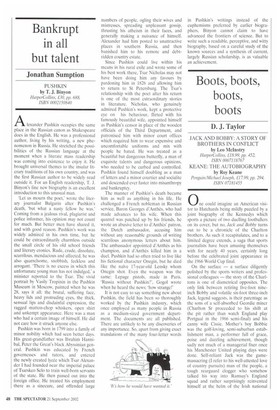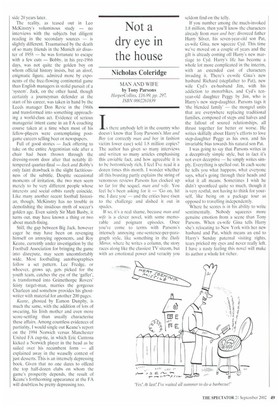Boots, boots, boots, boots
D. J. Taylor
JACK AND BOBBY: A STORY OF BROTHERS IN CONFLICT by Leo McInstry HarperCollins, £18.99, pp. 452, ISBN 0007118767 KEANE: THE AUTOBIOGRAPHY by Roy Keane Penguin/Michael Joseph, £17.99, pp. 294, ISBN 07181455 0 ne could imagine an American visitor to Hatchards being mildly puzzled by a joint biography of the Kennedys which sports a picture of two duelling footballers on its cover, but no, Jack and Bobby turns out to be a chronicle of the Charlton brothers. As such it recapitulates, and to a limited degree extends, a saga that sports journalists have been amusing themselves with for nearly 40 years, certainly long before the celebrated joint appearance in the 1966 World Cup final.
On the surface — a surface diligently polished by the sports writers and professional colleagues — the story of the Charltons is one of diametrical opposites. The only link between retiring five-foot nineinch Bobby and volatile six-foot three-inch Jack, legend suggests, is their parentage as the sons of a self-absorbed Geordie miner (Charlton Sr proceeded to his shift at the pit rather than watch England play Portgual in the 1966 semi-final) and his canny wife Cissie. Mother's boy Bobbie was the golf-loving, semi-suburban establishment man, a performer full of grace, poise and dazzling achievement, though sadly not much of a managerial fixer once his Manchester United playing days were done. Self-reliant Jack was the gamemassacring (I refer to his well-attested love of country pursuits) man of the people, a tough rearguard clogger who somehow talked his way into Ramsay's England squad and rather surprisingly reinvented himself at the helm of the Irish national
side 20 years later.
The reality, as teased out in Leo McKinstry's voluminous study — no interviews with the subjects but diligent reading in the secondary sources — is slightly different. Traumatised by the death of so many friends in the Munich air disas ter of 1958 he was fortunate to escape with a few cuts — Bobby, in his pre-1966 days, was not quite the golden boy on whom official history insists, but an aloof, enigmatic figure, admired more by exponents of the free-flowing continental game than English managers in stolid pursuit of a 'system'. Jack, on the other hand, though certainly a journeyman defender at the start of his career, was taken in hand by the Leeds manager Don Revie in the 1960s and transformed into something approaching a world-class act. Evidence of serious managerial intent came in an FA coaching course taken at a time when most of his fellow-players were contemplating postgame careers selling beer or newspapers.
Full of good stories — Jack offering to take on the entire Argentinian side after a chair had been thrown through the dressing-room door after that notably illtempered quarter-final —Jack and Bobby's only faint drawback is the slight factitiousness of the subtitle. Despite occasional moments of irritation, the two men seem merely to be very different people whose interests and social orbits rarely coincide. Like many another recent football historian. though, McKinstry has no trouble in demolishing the insidious myth of soccer's golden age. Even saintly Sir Matt Busby, it turns out, may have known a thing or two about match-fixing.
Still, the gap between Big Jack, however eager he may have been on revenging himself on annoying opponents. and Roy Keane, currently under investigation by the Football Association for bringing the game into disrepute, may seem uncomfortably wide. Most footballing autobiographies follow a set pattern. Lee Fredge, or whoever, grows up, gets picked for the youth team, catches the eye of the 'gaffer', is transformed into Grimethorpe Rovers' feisty target-man, marries the gorgeous Charleen and somehow provides his ghostwriter with material for another 200 pages.
Keane, ghosted by Eamon Dunphy, is much the same, with the addition of lots of swearing, his Irish mother and even more score-settling than usually characterise these affairs. Among countless evidences of partiality, I would single out Keane's report on the 1994 Norwich versus Manchester United FA cup-tie, in which Eric Cantona kicked a Norwich player in the head as he sailed over his recumbent form — all explained away in the weaselly context of just desserts. This is an intensely depressing book. Given that no one dares to offend the top half-dozen clubs on whom the game's prosperity depends, the result of Keane's forthcoming appearance at the FA will doubtless be pretty depressing too.











































































 Previous page
Previous page